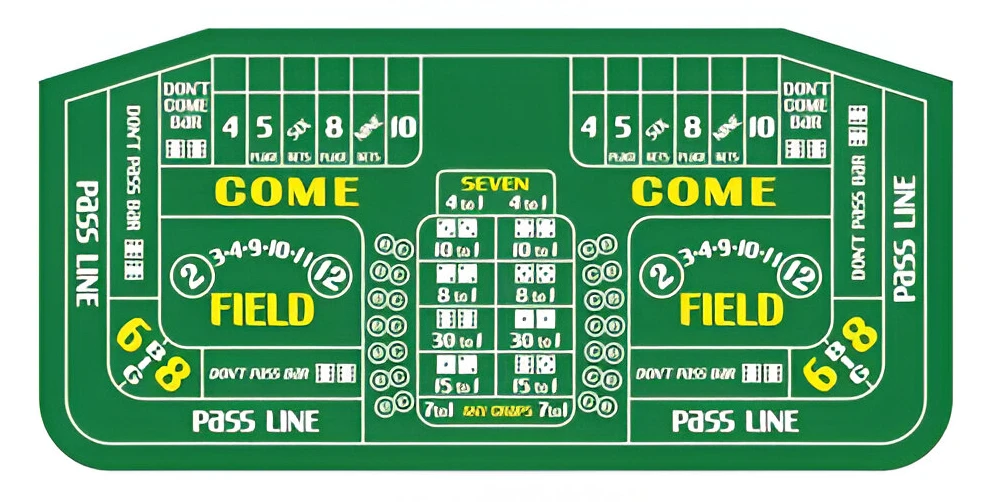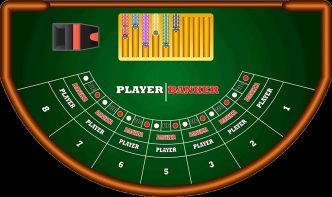Craps is a dynamic and engaging dice game that has captivated casino enthusiasts for decades. Its fast-paced nature, combined with a variety of betting options, makes it a favorite among both novice and seasoned gamblers. This guide aims to demystify the game, providing a thorough understanding of its rules, strategies, and nuances.
Craps is a casino dice game where players wager on the outcomes of a pair of dice rolls. The game’s objective is straightforward: predict the result of the dice roll. Despite its seemingly complex table layout and numerous betting options, the core mechanics are simple, making it accessible to newcomers.
Understanding the Craps Table Layout
 The craps table may appear intricate at first glance, but familiarizing yourself with its sections is crucial for effective gameplay.
The craps table may appear intricate at first glance, but familiarizing yourself with its sections is crucial for effective gameplay.
- Pass Line and Don’t Pass Line: Located at the front of the table, the Pass Line is where players place bets predicting that the shooter will win. Conversely, the Don’t Pass Line is for bets against the shooter.
- Come and Don’t Come Areas: These sections function similarly to the Pass and Don’t Pass lines but are used after a point has been established.
- Place Bets and Field Sections: The Place Bets area allows wagers on specific numbers (4, 5, 6, 8, 9, 10), while the Field section is for single-roll bets on 2, 3, 4, 9, 10, 11, or 12.
- Proposition Bets Area: Located at the center, this area is for high-risk, high-reward bets on specific outcomes, such as rolling a particular combination on the next roll.
Basic Rules and Gameplay
Understanding the flow of the game is essential for effective participation.
- The Role of the Shooter: The shooter is the player who rolls the dice. Each player gets a turn to be the shooter, moving clockwise around the table.
- The Come-Out Roll: The game begins with the come-out roll.
- Winning Outcomes (7 or 11): If the shooter rolls a 7 or 11, Pass Line bets win.
- Losing Outcomes (2, 3, or 12): If the shooter rolls a 2, 3, or 12 (known as “craps”), Pass Line bets lose.
- Establishing the Point (4, 5, 6, 8, 9, or 10): If any other number is rolled, it becomes the “point.” The dealer places a puck on this number to indicate the point.
- Rolling the Point:
- Winning by Hitting the Point Before a 7: The shooter continues to roll the dice, aiming to hit the point number again before rolling a 7. If successful, Pass Line bets win.
- Losing by Rolling a 7 Before the Point: If a 7 is rolled before the point number, it’s called “seven-out,” and Pass Line bets lose.
Types of Bets in Craps
Craps offers a variety of betting options, each with its own rules and payouts.
- Pass Line and Don’t Pass Line Bets:
- Pass Line: A bet that the shooter will win by rolling a 7 or 11 on the come-out roll or hitting the point before rolling a 7.
- Don’t Pass Line: A bet against the shooter, winning if a 2 or 3 is rolled on the come-out roll or if a 7 is rolled before the point number.
- Come and Don’t Come Bets:
- Come Bet: Similar to the Pass Line bet but placed after the point is established. It wins if the next roll is a 7 or 11.
- Don’t Come Bet: Similar to the Don’t Pass Line bet but placed after the point is established. It wins if the next roll is a 2 or 3.
- Place Bets: Wagers on specific numbers (4, 5, 6, 8, 9, 10) to be rolled before a 7.
- Field Bets: Single-roll bets that win if a 2, 3, 4, 9, 10, 11, or 12 is rolled.
- Proposition Bets: High-risk bets on specific outcomes, such as rolling a particular combination on the next roll.
- Odds Bets: Additional bets that can be placed behind Pass, Don’t Pass, Come, and Don’t Come bets, offering true odds with no house edge.
Payouts and House Edge
Understanding payouts and the house edge is crucial for informed betting.
- Standard Payouts for Common Bets:
- Pass Line and Come Bets: Pay even money (1:1).
- Don’t Pass and Don’t Come Bets: Pay even money (1:1).
- Place Bets: Payouts vary depending on the number:
- 4 or 10: 9:5
- 5 or 9: 7:5
- 6 or 8: 7:6
- House Edge for Various Bets:
- Pass Line and Come Bets: Approximately 1.41%.
- Don’t Pass and Don’t Come Bets: Approximately 1.36%.
- Place Bets: Vary depending on the number:
- 4 or 10: 6.67%
- 5 or 9: 4.00%
- 6 or 8: 1.52%
Strategies to Minimize the House Edge
To enhance your chances of success in craps, it’s essential to focus on bets with the lowest house edge and employ effective betting strategies.
- Pass Line and Come Bets: These bets have a relatively low house edge of approximately 1.41%, making them favorable options for players.
- Don’t Pass and Don’t Come Bets: With a slightly lower house edge of about 1.36%, these bets are also advantageous, though they involve betting against the shooter.
- Taking Odds: After a point is established, you can place an additional bet known as the “odds” bet behind your original Pass Line or Come bet. This bet pays true odds and has no house edge, effectively reducing the overall house advantage on your combined wager.
- Avoid High House Edge Bets: Steer clear of proposition bets and certain Place bets, as they carry a higher house edge, increasing the likelihood of losses over time.
Craps Etiquette and Tips
Proper etiquette and strategic tips can enhance your craps experience and improve your gameplay.
- Proper Behavior at the Table:
- Handle Chips Correctly: Place your bets in the appropriate areas without reaching across the table or interfering with the dice.
- Respect the Shooter: Avoid distracting the shooter and refrain from making loud comments during their roll.
- Follow Dealer Instructions: Pay attention to the dealers and adhere to their guidance to maintain a smooth game flow.
- Common Superstitions and Practices:
- Avoid Saying “Seven”: Many players consider mentioning the number seven as bad luck during a roll.
- Blowing on the Dice: Some shooters believe that blowing on the dice brings good luck.
- Rhythmic Rolling: Maintaining a consistent rhythm in rolling the dice is thought to influence outcomes favorably.
- Tips for Beginners:
- Start with Simple Bets: Begin with Pass Line and Come bets to familiarize yourself with the game’s flow.
- Manage Your Bankroll: Set a budget for your session and stick to it to avoid significant losses.
- Observe Before Playing: Spend time watching the game to understand the dynamics and betting patterns.
Variations of Craps
Craps has several variations that offer unique twists on the traditional game.
- Street Craps: A simplified version played informally without a table, often in casual settings. The rules are similar but lack the complex betting options of casino craps.
- Online Craps: Digital versions of the game available on various online casino platforms, allowing players to enjoy craps from the comfort of their homes.
- Live Dealer Craps: Combines the convenience of online play with the authentic experience of a live dealer, streamed in real-time to your device.
Advanced Strategies and Techniques
For players looking to deepen their understanding and potentially enhance their performance in craps, exploring advanced strategies can be beneficial.
- Dice Control (Controlled Shooting):
- Concept: Dice control involves attempting to influence the outcome of the roll by controlling the way the dice are thrown. This includes setting the dice in a specific manner and delivering them with a consistent grip, angle, and velocity to reduce randomness.
- Controversy: The effectiveness of dice control is a subject of debate. While some players claim success, many experts argue that the inherent randomness of dice rolls, especially after hitting the back wall of the table, makes consistent control highly improbable.
- Betting Systems:
- Oscar’s Grind: This positive progression betting system aims to capitalize on winning streaks while minimizing losses during downturns. The player increases the bet size after a win and maintains or decreases it after a loss, seeking to achieve a net profit of one unit per series.
- Iron Cross Strategy: This approach involves covering multiple numbers to increase the chances of a win on each roll. Players place bets on the Field and Place bets on 5, 6, and 8. While it offers frequent small wins, the strategy can be vulnerable to losses if a 7 is rolled.
- Bankroll Management:
- Setting Limits: Determine a fixed amount for your gambling session and adhere to it. This discipline helps prevent significant financial losses.
- Win and Loss Thresholds: Establish specific points at which you’ll walk away, whether you’re ahead or behind. This strategy aids in preserving winnings and limiting losses.
Common Mistakes to Avoid While playing Craps
Being aware of common pitfalls can improve your craps experience and outcomes.
- Chasing Losses: Attempting to recover losses by increasing bet sizes can lead to more significant losses. It’s essential to stick to your predetermined betting strategy and limits.
- Ignoring the House Edge: Not all bets are created equal. Focusing on bets with a lower house edge, such as Pass Line and Come bets, can enhance your chances over time.
- Overlooking Etiquette: Disregarding table etiquette can disrupt the game and annoy other players. Always be courteous, handle chips properly, and respect the flow of the game.
Practicing and Improving Your Skills
- Online Simulations: Many online platforms offer free craps simulations, allowing you to practice without financial risk. This practice can help you become comfortable with the game’s flow and betting options.
- Learning from Experienced Players: Observing and interacting with seasoned players can provide valuable insights and tips that aren’t always found in guides.
- Continuous Learning: Stay updated with new strategies, variations, and discussions about craps. Engaging with the craps community through forums and articles can enhance your understanding and enjoyment of the game.







